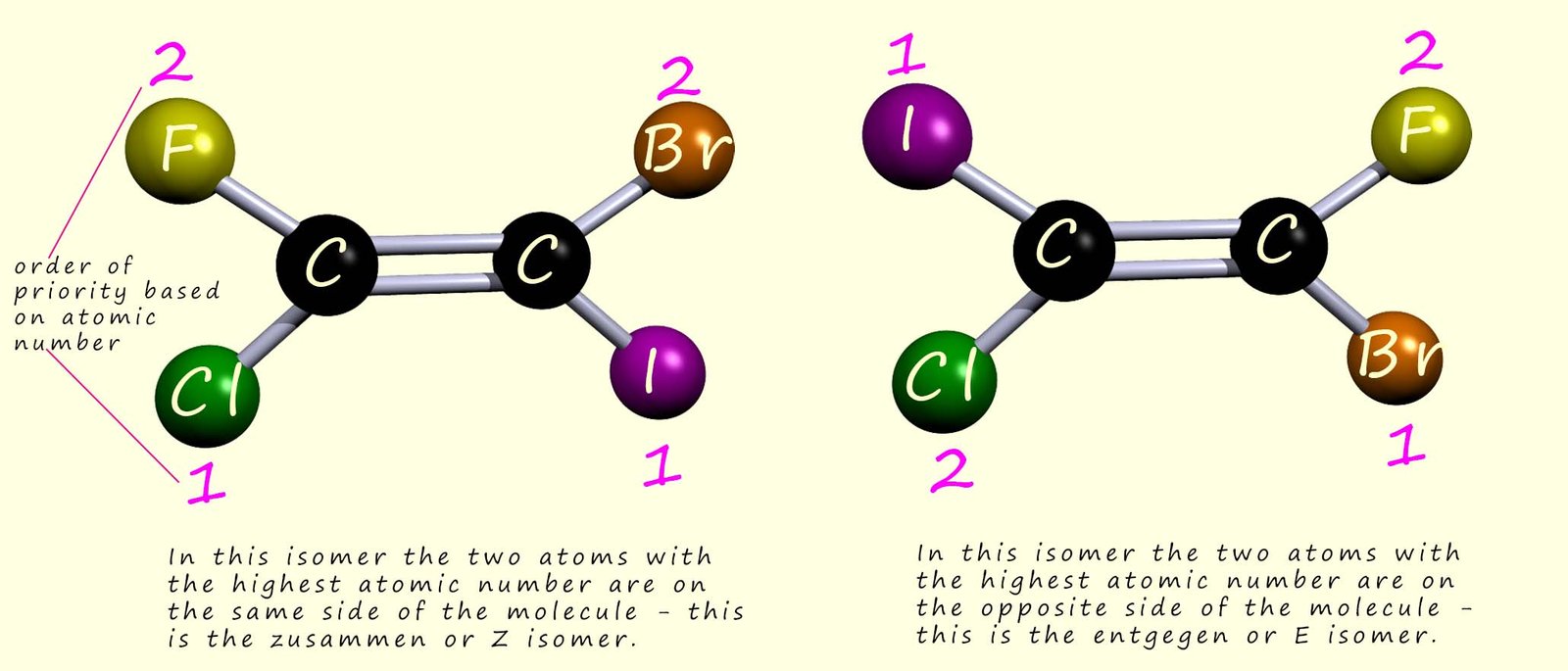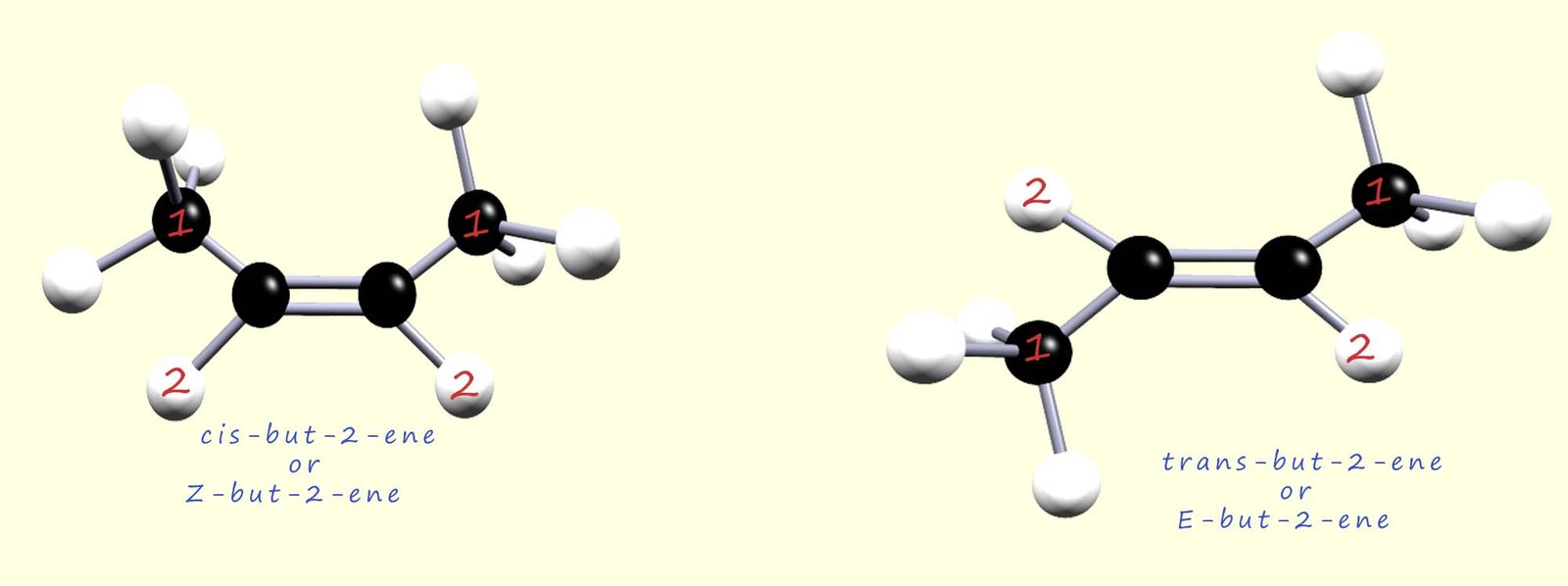
Stereoisomers are compounds which have the same structural formula but the atoms are arranged differently in 3d space.
There are two types of stereoisomers:
The diagram below shows two molecules of 1,2-dichloroethane (C2H4Cl2). These two molecules appear to have a different shape from each other; so are they isomers? They have the same structural formula but the atoms are arranged differently in 3d space, they appear to fit the definition for a stereoisomer!

At first glance you may think that these two molecules are
indeed isomers however they are NOT. The reason they are not
isomers is simple enough; there is free rotation
about the carbon-carbon bond.
If you can imagine that each of the carbon atoms and all the groups attached to them are in
constant rotation;
this means that these two
apparent isomers are actually the same compound. It is possible to
convert one of these apparent isomers into the other by
simply rotating the carbon-carbon bond as shown below:

However if we could restrict or stop the rotation about the C-C bond then we would indeed have two stereoisomers. The molecules shown below are alkenes which contain the C=C functional group. The presence of the double covalent bond between the atoms of carbon stops any rotation:

How would we name these two different geometric isomers of 1,2-dichloroethene?
The traditional method of naming these two isomers is using the
prefixes cis and trans. In the
cis-isomer both the
chlorine atoms are on the same side of the molecule
and the hydrogen atoms are on the other, whereas in the trans-isomer
the two chlorine atoms are on opposite sides of the
molecule. This is shown below:

But-2-ene exists as a pair of geometric isomers. The cis and trans isomers of but-2-ene are shown below. In the cis-isomer the two methyl groups (CH3) attached to the carbon atoms in the C=C are on one side of the molecule whereas in the trans-isomer the two methyl groups (CH3) are on opposite sides of the molecule:


Care is needed in deciding if a particular alkene will show
geometric isomerism; that is have a cis and
trans isomer. The
main requirement for cis/trans isomerism is that the two groups
bonded to each of the carbon atoms in the carbon-carbon
double bond (C=C) are different. The
cis/trans naming system is used to
name disubstituted alkenes.
So ethene shown opposite will not have cis/trans isomers since
each of the carbon atoms in the carbon-carbon double bond is bonded
to identical hydrogen atoms.
In the example above but-2-ene can exist as a pair of geometric isomers however but-1-ene does not have any cis/trans isomers. The reason for this is the same reason why ethene has no geometric isomer, two of the atoms attached to one of the carbon atoms in the C=C are the same. This is shown below:

In the examples used above to illustrate cis-trans isomerism we used alkene that were disubstituted with two different groups on each carbon atom in the C=C but the groups were the same on each of the carbon atoms in the C=C. However the cis-trans naming system while very useful has some limitations for example the two molecules shown below are stereoisomers (geometric isomers). It would prove impossible to identify which is the cis and which is the trans isomer based on the information above.

An improved naming system called the E-Z system can be used to describe these two
geometric isomers. This system
basically uses the atomic number (to be more precise it uses the (Cahn-Ingold-Prelog rules) of the atom attached to the carbon
atom in the carbon-carbon double bond (C=C) to
put the atoms in order of priority. So for the two
geometric isomers
mentioned above the numbers beside the atoms in the image below
are the orders of priority of the atoms based on their
atomic number. The higher the atomic number of the
attached atom the higher
is its priority rating.
If the two higher priority groups are on the
same side of the molecule then the
molecule is designated the Z-isomer (
z for zusammen, German for together) and if the two groups of higher priority
are on opposite sides of the molecule
then
this isomer is designated the E-isomer (e for entgegen, German for opposite). This is outlined in the image below:

So although the cis-trans naming system does not work for all
molecules it is still widely used in chemistry to name
disubstituted alkenes and you should not dismiss it
out of hand, you will meet lots of molecules which are described using this system
however the E-Z system has the advantage over the
cis-trans
system in that it works for all molecules.
However it is clearly possible to use both systems to describe simple molecules;
the image below is of the cis-trans isomers of but-2-ene but they
are also identified using the E-Z system where
the order of priority of the atoms/groups attached to the carbon atoms in the
C=C are labelled.
